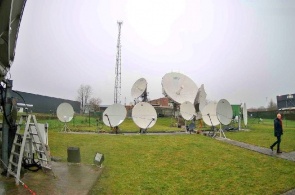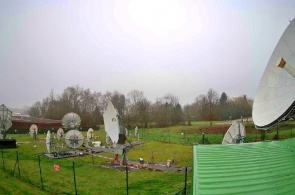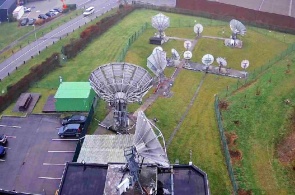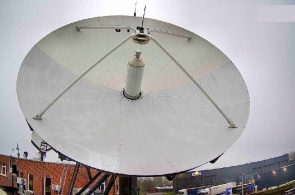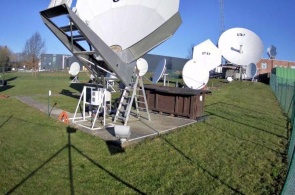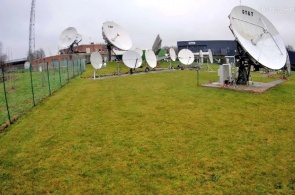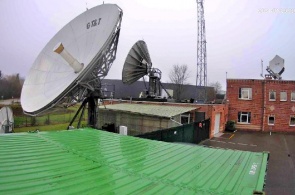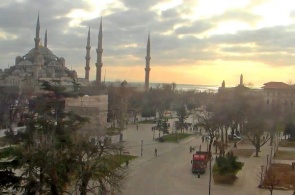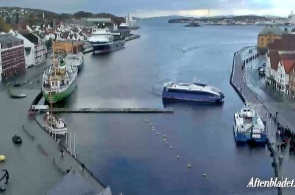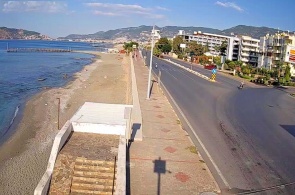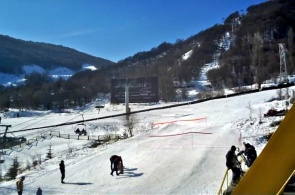Web camera number 4. A real-time webcam from the base of the European company GlobalTT operating in the sector of satellite Internet teleport services. GlobalTT is located in einstein's Science Park in Louve-la-Nev, close to Brussels.
Brussels is the heart of Europe and the unofficial capital of the European Union. It is worth visiting here at least for the sake of seeing luxurious palaces, ancient architecture, unusual fountains and sculptures. Thousands of tourists come here to visit unique museums and galleries, and then sit in a cozy cafe or bar. There is a truly unique atmosphere, which should be felt by everyone who loves to travel and learn new things.
Brussels is in the centre of Belgium. Although the city stands on the Senne River, you will not see it, because, as early as the 19th century, as a result of urbanization, it was blocked by Belgian engineers. Start exploring the city from the central square of Gran Plas (Grote-Markt), where the town hall and the House of the King are located, as well as other historic buildings dating back to the 17th century. The architectural ensemble of the square is listed as a UNESCO heritage site.
Brussels, literally, translates as "village on a swamp." Legends say that the city was founded in the 6th century by St. Hagerik, Bishop of Cambrai, whose statue is depicted on the gates of the town hall. However, the documentary mention of the village of Bruocsella appears only in the 10th century. Gradually the village grew, there were new fortifications. In the 12th and 13th centuries, crafts and trade were actively developed. It is natural that the city began to look for greater independence. In 1302, the townspeople achieved the creation of the City Council, which represented the interests of artisans of different layers.
In the 15th century, Brussels became the capital of Burgundy. The town hall and the earliest buildings on Grand Place are under construction. The city is actively developing, sculptors, jewelers and artists come here. Among the artists we know, Peter-Senior Bruegel and Rogier van der Weyden (who was the city's official artist) lived here.
In 1531, the construction of the Willenbrock Canal began, making Brussels a seaport. After the uprising of the Netherlands against Spain and repression by the Spanish authorities, the city began to drain the "brains" - the elite fled to Amsterdam. As a result, the period of economic decline of Brussels began.
After the Thirty Years' War, in the Westphalia world of 1648, the northern part of the Netherlands became independent, and the southern part - with Brussels, remained under Spanish rule.
Under Louis XIV, France actively conquered new territories. In 1695, Brussels was besieged, and enemy artillery shelled the city for 36 hours in a row. As a result, the city center was almost completely destroyed and destroyed the heritage of past eras. A little later, the French left the territory of Belgium, and in the early 18th century, the Austrian Habsburgs gained control over Brussels.
The French ascended to the late 18th and early 19th centuries. Later, after Napoleon's final defeat, the Southern Netherlands joined the Northern By decision of the Congress of Vienna 1814-1815. Already in 1830, as a result of the revolution, a new state - Belgium (constitutional monarchy, in the form of government) appeared.
Brussels is entering an era of industrialization, the population is actively growing, and the territory of the city is increasing by combining with the nearest rural communes. It was in the second half of the 19th century that the Senna River overlapped and a number of famous structures were built (the exchange, the Royal Palace, the Arc de Triomphe and others).
The First and Second World Wars did not have a significant impact on the appearance of the city, although it was captured by Germany. In the 1950s, Brussels became an international political and diplomatic center. Here, in 1958, the headquarters of the European Economic Community (future EU) appears. At the same time, the city hosted the World Exhibition, which is associated with the appearance of the symbol of the atomic age - Atomium, one of the main attractions of the city. In 1967, NATO's headquarters appeared in Brussels.
At the same time, in the 1960s and 1970s, Brussels was undergoing the modernization of urban areas, which consisted of the demolition of historic neighborhoods and the development of the territory with high-rise buildings. Later this phenomenon was called "Brusselsization." In order to preserve the historical appearance of the city, in the 1990s the so-called "facadeism" began to be practiced - to reconstruct the buildings, preserving the historical facade.
Brussels is the heart of Europe and the unofficial capital of the European Union. It is worth visiting here at least for the sake of seeing luxurious palaces, ancient architecture, unusual fountains and sculptures. Thousands of tourists come here to visit unique museums and galleries, and then sit in a cozy cafe or bar. There is a truly unique atmosphere, which should be felt by everyone who loves to travel and learn new things.
Brussels is in the centre of Belgium. Although the city stands on the Senne River, you will not see it, because, as early as the 19th century, as a result of urbanization, it was blocked by Belgian engineers. Start exploring the city from the central square of Gran Plas (Grote-Markt), where the town hall and the House of the King are located, as well as other historic buildings dating back to the 17th century. The architectural ensemble of the square is listed as a UNESCO heritage site.
Brussels, literally, translates as "village on a swamp." Legends say that the city was founded in the 6th century by St. Hagerik, Bishop of Cambrai, whose statue is depicted on the gates of the town hall. However, the documentary mention of the village of Bruocsella appears only in the 10th century. Gradually the village grew, there were new fortifications. In the 12th and 13th centuries, crafts and trade were actively developed. It is natural that the city began to look for greater independence. In 1302, the townspeople achieved the creation of the City Council, which represented the interests of artisans of different layers.
In the 15th century, Brussels became the capital of Burgundy. The town hall and the earliest buildings on Grand Place are under construction. The city is actively developing, sculptors, jewelers and artists come here. Among the artists we know, Peter-Senior Bruegel and Rogier van der Weyden (who was the city's official artist) lived here.
In 1531, the construction of the Willenbrock Canal began, making Brussels a seaport. After the uprising of the Netherlands against Spain and repression by the Spanish authorities, the city began to drain the "brains" - the elite fled to Amsterdam. As a result, the period of economic decline of Brussels began.
After the Thirty Years' War, in the Westphalia world of 1648, the northern part of the Netherlands became independent, and the southern part - with Brussels, remained under Spanish rule.
Under Louis XIV, France actively conquered new territories. In 1695, Brussels was besieged, and enemy artillery shelled the city for 36 hours in a row. As a result, the city center was almost completely destroyed and destroyed the heritage of past eras. A little later, the French left the territory of Belgium, and in the early 18th century, the Austrian Habsburgs gained control over Brussels.
The French ascended to the late 18th and early 19th centuries. Later, after Napoleon's final defeat, the Southern Netherlands joined the Northern By decision of the Congress of Vienna 1814-1815. Already in 1830, as a result of the revolution, a new state - Belgium (constitutional monarchy, in the form of government) appeared.
Brussels is entering an era of industrialization, the population is actively growing, and the territory of the city is increasing by combining with the nearest rural communes. It was in the second half of the 19th century that the Senna River overlapped and a number of famous structures were built (the exchange, the Royal Palace, the Arc de Triomphe and others).
The First and Second World Wars did not have a significant impact on the appearance of the city, although it was captured by Germany. In the 1950s, Brussels became an international political and diplomatic center. Here, in 1958, the headquarters of the European Economic Community (future EU) appears. At the same time, the city hosted the World Exhibition, which is associated with the appearance of the symbol of the atomic age - Atomium, one of the main attractions of the city. In 1967, NATO's headquarters appeared in Brussels.
At the same time, in the 1960s and 1970s, Brussels was undergoing the modernization of urban areas, which consisted of the demolition of historic neighborhoods and the development of the territory with high-rise buildings. Later this phenomenon was called "Brusselsization." In order to preserve the historical appearance of the city, in the 1990s the so-called "facadeism" began to be practiced - to reconstruct the buildings, preserving the historical facade.
More details
Webcam No. 8. Live online broadcast from the GlobalTT database operating in the sector of satellite Internet solutions. GlobalTT is located in Louvain-La-Neuve, Belgium. The capital of Belgium is Brussels, a distinctive, unusual and interesting city. It is infused with the aroma of chocolate, hot waffles and freshly brewed beer. Its streets are fraught with many historical monuments and masterpieces of modern architecture, cozy cafes and shops.
Louvain-la-Neva, Belgium
10.03.21
Web camera number 7. Live live broadcast from the globalTT base operating in the sector of simple and complex satellite Internet solutions. GlobalTT is located in einstein's Science Park in Louve-la-Nev, close to Brussels.
Louvain-la-Neva, Belgium
10.03.21
Webcam No. 6. Webcam in real time from the base of the European company GlobalTT operating in the sector of satellite Internet solutions. GlobalTT is located in the Einstein Science Park in Louvain-la-Neuve, just outside Brussels.
Louvain-la-Neva, Belgium
10.03.21
Web camera number 5. An online webcam from the base of the European company GlobalTT operating in the sector of simple and complex satellite Internet solutions. GlobalTT is located in the Einstein Science Park in Louve la Nev, Brussels.
Louvain-la-Neva, Belgium
10.03.21
Web camera number 3. Live online broadcast from the base of the European company GlobalTT, working in the sector of simple and complex satellite Internet solutions. GlobalTT is located in the Einstein Science Park in Louve la Nev, close to Brussels.
Louvain-la-Neva, Belgium
06.03.21
Web camera number 2. A real-time webcam from the base of the European company GlobalTT operating in the sector of satellite Internet teleport services. GlobalTT is located in the Einstein Science Park in Louve la Nev, close to Brussels.
Louvain-la-Neva, Belgium
06.03.21
popular camerasshow all
Sultanahmet or Blue mosque is a work of art of Turkish-Islamic architecture. Its construction began in 1609, the construction work took seven years to a 19-year-old Sultan. The name of the mosque was, due to its interesting and unique finish.
Istanbul, Turkey
Stavanger, a town in the commune of Norway, located in the South-Western part of the country, on the Peninsula, rich in minerals. Tanager combines the influence of foreign organisations such as NATO and oil companies. The camera will shoot the harbour and the promenade of the city.
Stavanger, Norway
A webcam broadcasts the district of Tosmur - quiet location in the Eastern part of Alanya, located only five kilometres from the city centre. Its rural way of life and the beauty of untouched nature attract tourists.
Alanya, Turkey
Shark Island or in English of Shark island, located in the harbour city of Sydney, the suburb of Point Piper. The locals, the natives named the island Boambilly, which translated means Shark island. After all, this name is not casual, because it's mean and looks like a shark fin.
Sydney, Australia
The webcam is installed on site Alva. Tsaghkadzor ski resort town in Armenia. Tsaghkadzor is a beautiful mountainous area among deciduous forests, with a pleasant winter climate, and clean fresh air. The highest point is 1800 meters. The truss type is a classic, divided into three.
Tsakhkadzor, Armenia
